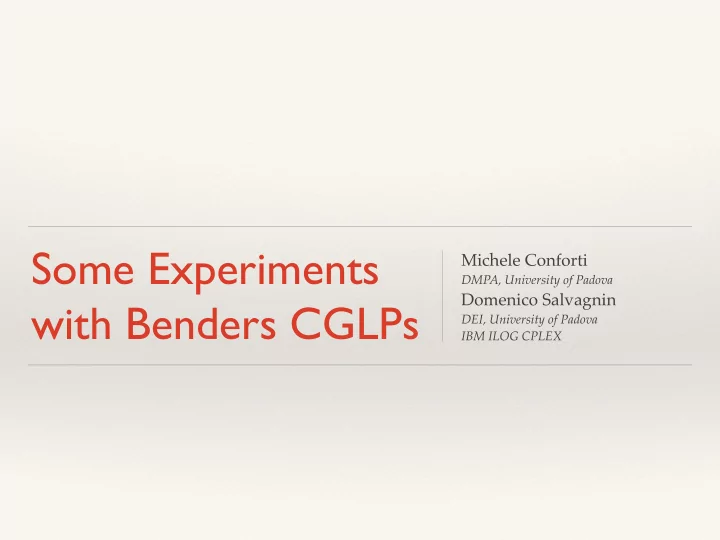

Some Experiments Michele Conforti DMPA, University of Padova Domenico Salvagnin with Benders CGLPs DEI, University of Padova IBM ILOG CPLEX
master CGLP
Basic Benders CGLP structure same objective same variables are fixed! same size and structure of original model Given a dual solution π , cut coefficients can be easily read as (minus) the reduced costs of master variables x!
When to use Benders? ❖ To exploit a block decomposition on the continuous part ❖ To take advantage of problem simplification VUBs when master variables as fixed
How strong is a Benders cut? η This for optimality cuts, for feasibility ones we know nothing. Is there a way to always get x domain x a facet? dominated facet undominated
Yes! to the rescue ❖ Needs a corepoint x 0 ❖ Find furthest point on the line segment which is still within the x 0 max λ polyhedron P of interest ❖ Works with any CGLP! ❖ Returns a facet of P… x* ❖ …with probability 1* *handle with care!
Effect on Benders CGLP different objective original objective added as constraint one more variable Given a dual solution π , cut coefficients can still be easily read as (minus) the reduced costs of master variables, but…
Side effects ❖ New column potentially dense and numerically nasty ❖ Objective constraint: even worse :-( ❖ VUBs do not simply to simple bounds anymore ❖ No warm starts: changing x* changes a basic column! I would have never implemented it… hadn’t Michele been so stubborn ;-)
Implementation ❖ CPLEX implements Benders decomposition since 12.7 ❖ Reasonable implementation with some bells & whistles: ❖ special handling of VUBs x 0 ❖ simple normalization for feasibility cuts ❖ can separate rays (for unbounded y masters) ❖ Specific Benders heuristics ❖ in-out separation strategy x* ❖ Can it be improved with the new CGLP?
Preliminary (negative) results ❖ Special VUB handling critical for some models: ❖ New CGLP prevents it :-( ❖ ⇒ 20-30x slowdown on those ❖ Objective numerics can be insane!!! ❖ dynamism >10 10 and dense ❖ ⇒ invalid cuts/convergence failures ❖ Need to disable the new CGLP in those cases.
Computational Results in-out Kelley in-out 4.00 3.66 3.00 slowdown 2.54 2.00 1.00 1.01 1.00 0.94 0.00 defaults CW Kelley Kelley+CW CW-noobj Internal testbed of 330 models, 5 random seeds
Computational Results: CW-noobj Affected models (~9%) 1.00 0.94 0.83 0.75 slowdown 0.50 0.52 0.25 0.13 0.00 Time Nodes Time Nodes Internal testbed of 330 models, 5 random seeds
Conclusions ❖ As usual, theory ≠ practice (lots of side effects) ❖ For optimality cuts, textbook CGLP still seems the better choice, provided a good separation scheme ( in-out ) is used ❖ For feasibility cuts, new CGLP pays off handsomely :-) ❖ Work in progress, stay tuned!
Recommend
More recommend